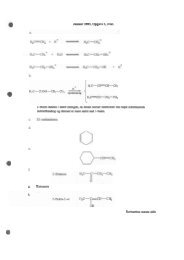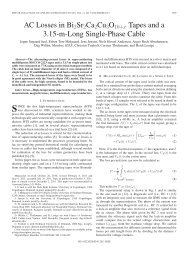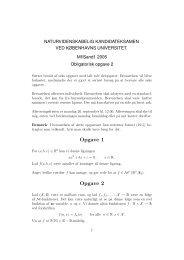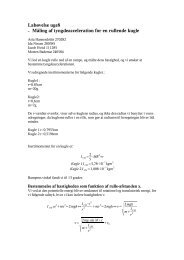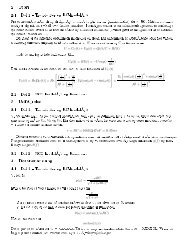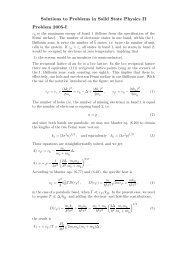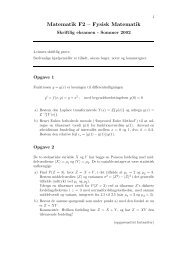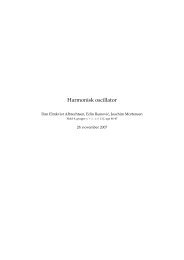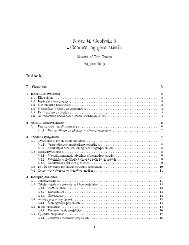<strong>Simul<strong>at</strong>ions</strong> <strong>of</strong> <strong>Chopper</strong> <strong>Jitter</strong> <strong>at</strong> <strong>the</strong> <strong>LET</strong> <strong>Neutron</strong> <strong>Spectrometer</strong> <strong>at</strong> <strong>the</strong> ISIS TS2 4Figure 3. A picture <strong>of</strong> <strong>the</strong> actual Res 2 chopper, where <strong>the</strong> double slits are clearlyvisible.SampleRes2CRPRRes1 & FOGuide startFigure 4. Flight distance vs time in ray tracing, showing <strong>the</strong> ”white” beam from<strong>the</strong> moder<strong>at</strong>or in <strong>the</strong> energy range 4.9-5.1 meV, being separ<strong>at</strong>ed into a few distinctwavelengths by <strong>the</strong> first resolution choppers (Res1) <strong>at</strong> 7.83 m, with <strong>the</strong> desiredwavelength singled out by <strong>the</strong> pulse removal (PR) chopper <strong>at</strong> 11.75 mresolution choppers (Res1). The desired wavelength is singled out by <strong>the</strong> slow pulseremoval (PR) chopper, as can be seen in <strong>the</strong> energy distribution in fig. 5.Note also <strong>the</strong> novel double funnel system <strong>at</strong> <strong>the</strong> Res2 choppers, seen in fig. 2,designed to fur<strong>the</strong>r increase <strong>the</strong> resolution <strong>of</strong> <strong>the</strong> instrument, by allowing more narrowchopper windows, without sacrificing neutron flux.[5]
<strong>Simul<strong>at</strong>ions</strong> <strong>of</strong> <strong>Chopper</strong> <strong>Jitter</strong> <strong>at</strong> <strong>the</strong> <strong>LET</strong> <strong>Neutron</strong> <strong>Spectrometer</strong> <strong>at</strong> <strong>the</strong> ISIS TS2 53. <strong>Chopper</strong> <strong>Jitter</strong>Physical beam choppers are never perfectly <strong>at</strong> <strong>the</strong> desired phase, but r<strong>at</strong>her devi<strong>at</strong>e bya random error <strong>at</strong> any given time. Whereas most neutron simul<strong>at</strong>ions are performedwith m<strong>at</strong>hem<strong>at</strong>ically perfect beam choppers, here a random phase error (jitter) is addedto give more physically realistic choppers. For <strong>the</strong> purposes <strong>of</strong> this article we choose <strong>the</strong>jitter to be Gaussian, parametrized by <strong>the</strong> width <strong>of</strong> <strong>the</strong> Gaussian error[6]The size <strong>of</strong> <strong>the</strong> jitter is <strong>the</strong>n defined as <strong>the</strong> width <strong>of</strong> <strong>the</strong> Gaussian error, which is usedas <strong>the</strong> jitter parameter.For every event where a neutron ray reaches a chopper, <strong>the</strong> phase θ is calcul<strong>at</strong>ed thus:θ = θ 0 + j ∗ rand norm ∗ ω (1)Where θ 0 is <strong>the</strong> chopper position without jitter, j is <strong>the</strong> jitter parameter for <strong>the</strong> chopperwith units <strong>of</strong> time, rand norm is a normalized Gaussian random number (with σ 2 = 1)and ω is <strong>the</strong> angular velocity <strong>of</strong> <strong>the</strong> chopper.To illustr<strong>at</strong>e <strong>the</strong> effect <strong>of</strong> chopper jitter, we consider <strong>the</strong> basic equ<strong>at</strong>ion for flight time:t = α ∗ λ ∗ L (2)where λ is <strong>the</strong> neutron wavelength, L is <strong>the</strong> flight length, and <strong>the</strong> constant α isα = m n /h ≈ 252 µs/m/Å.[10]Hence, if <strong>the</strong> jitter is <strong>the</strong> only source <strong>of</strong> uncertainty, we have th<strong>at</strong> <strong>the</strong> uncertainty in <strong>the</strong>wavelength is:dλ = dt(3)αLSo for a realistic jitter value, (dt), <strong>of</strong> 0.4 µs in <strong>the</strong> second resolution choppers, loc<strong>at</strong>ed <strong>at</strong>15.7 m from Res1, this contribute to <strong>the</strong> uncertainty in <strong>the</strong> wavelength (dλ) <strong>of</strong> 6*10 −5 Å,and thus a dE <strong>of</strong> 0.1 µeV for 5 meV neutrons. In comparison <strong>the</strong> resolution is <strong>at</strong> about20 µeV <strong>at</strong> 250 Hz.Since <strong>the</strong> energy <strong>of</strong> neutrons arriving in <strong>the</strong> physical detector bank is calcul<strong>at</strong>ed by<strong>the</strong> ToF-method, a small discrepancy in <strong>the</strong> arrival time <strong>at</strong> <strong>the</strong> sample, can, over <strong>the</strong> 3.5m from <strong>the</strong> sample to detector, transl<strong>at</strong>e into a much larger difference in <strong>the</strong> neutronenergy perceived by <strong>the</strong> detector. Considering again <strong>the</strong> jitter dt = 0.4 µs in <strong>the</strong> 2ndresolution choppers, this corresponds to an uncertainty in <strong>the</strong> perceived wavelength (dλ)<strong>of</strong> 510 −4 Å, and thus a dE <strong>of</strong> 1 µeV for 5 meV neutrons.Some neutron instruments compens<strong>at</strong>es for jitter with a ’veto’ system, where anevent is discarded if an unacceptable discrepancy <strong>of</strong> <strong>the</strong> chopper phase is detected. Theveto scheme is not included in <strong>the</strong> present simul<strong>at</strong>ions.4. Simul<strong>at</strong>ion resultsThe instrument was built in <strong>the</strong> McStas neutron simul<strong>at</strong>ion package[2, 3], by adding<strong>the</strong> physical components (moder<strong>at</strong>or, guide sections, beam choppers) sequentially, with



